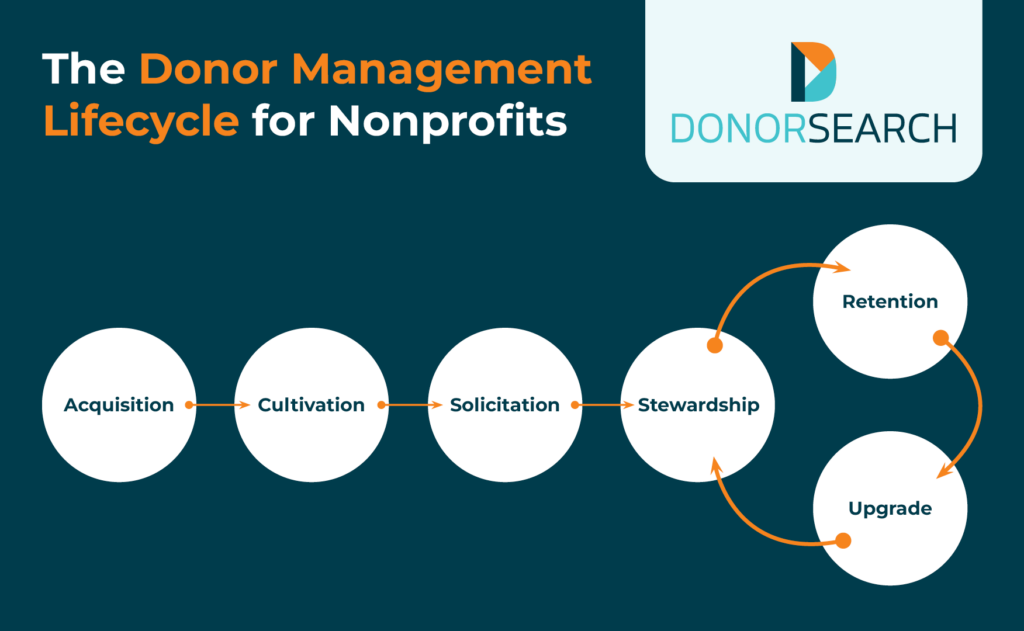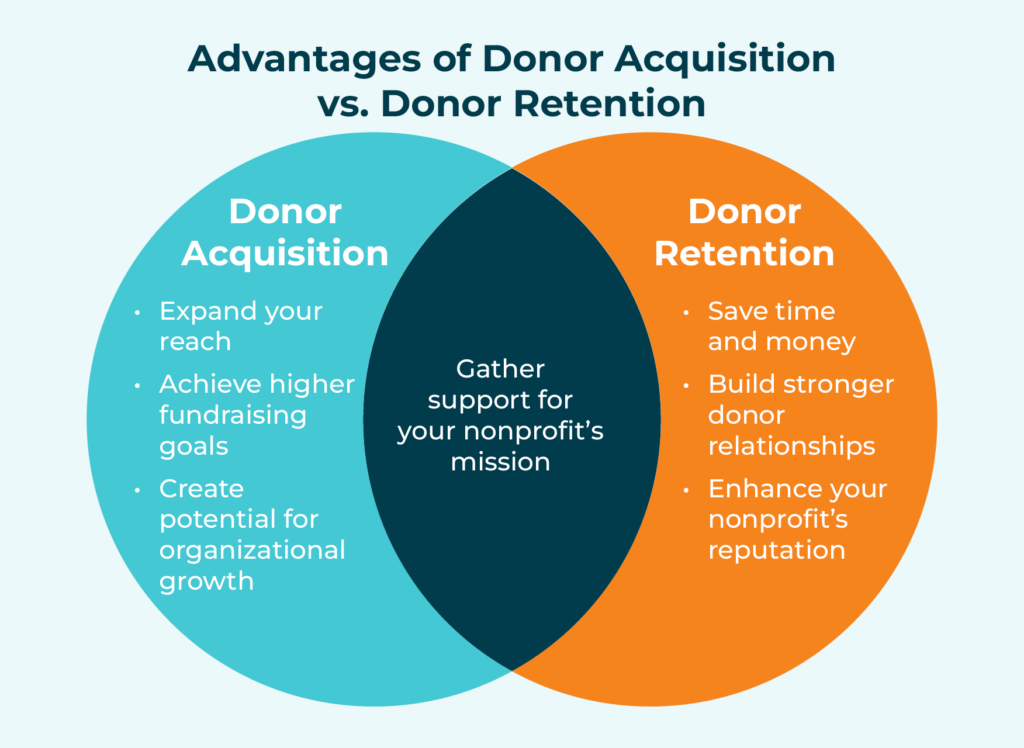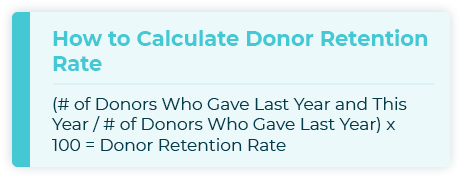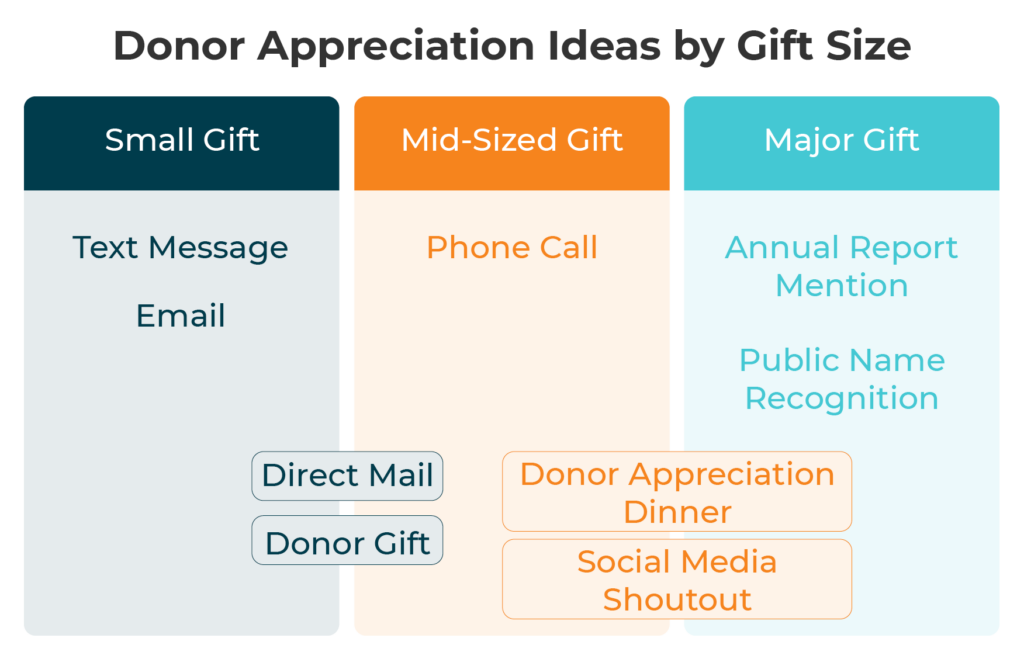
Nonprofit Donor Retention: How to Secure Long-Term Support
Building relationships with your nonprofit’s donors is essential to secure reliable support for your mission. When a donor feels like an integral part of your organization’s community and knows that their gifts have made a difference, they’ll be more likely to stay engaged and donate again. In other words, you’re more likely to retain that donor.
In this guide, we’ll walk through everything your nonprofit needs to know about donor retention! Here is what we’ll cover:
- Donor Retention FAQ
- Strategies to Retain Your Nonprofit’s Donors
- Essential Tools for Donor Retention
Keep in mind that the more a donor has given to your organization, the more important it is to retain them. While we’ll provide tips for donor retention at every level, you should develop plans to secure major donors’ long-term buy-in first and work downward from there to set your nonprofit up for future fundraising success.

Donor Retention FAQ
Let’s begin by answering some of the most common questions about donor retention to help you better understand what it is and why it’s important.
What is donor retention?
Donor retention is the process of maintaining relationships with your nonprofit’s existing donors to secure their ongoing support. It involves ensuring donors feel connected to, valued by, and satisfied with your organization so they’ll want to keep contributing at or above their current level year after year.
The opposite of donor retention is donor attrition or churn, which happens when a donor stops engaging with your nonprofit. Supporters who have disengaged for a specified period of time (often one year) are considered lapsed donors.
Why do donors lapse?
There are many reasons why a donor might stop supporting your nonprofit, but the most common ones include:
- Changes in their financial situation. Of course, your organization can’t do anything about this issue directly, although you can encourage these donors to stay engaged through free activities such as volunteering or advocacy so you don’t entirely lose their support.
- Lack of engagement. Your donors are busy, and receiving too few communications from your nonprofit can cause other issues to take precedence in their minds.
- Donor fatigue. On the flip side, getting too many donation requests from your organization can cause donors to experience burnout.
- Feeling unappreciated or undervalued. Not thanking donors for their contributions or sending them too many generic messages can give them the impression that your nonprofit just sees them as revenue sources rather than members of its community.
- Uncertainty about their gifts’ impact. If donors don’t know how your organization is using their contributions to further its mission, they might decide that donating isn’t actually worth it.
- Loss of confidence. This is why protecting your nonprofit’s status and reputation is critical—donors want to be associated with organizations in good legal, financial, and social standing.
Understanding the reasons your donors might lapse allows you to take proactive steps to reduce attrition rates and retain as much support as possible.
How does retention fit into the larger donor journey?
Retention is the fifth step in the six-part donor management lifecycle, which describes the way in which individuals transition from unengaged prospects into dedicated supporters of your mission. Your team will guide donors from one step to the next using a procedure known as moves management.

The first step in the process, acquisition, occurs when your nonprofit makes first contact with a potential donor through marketing or direct outreach. Next, you’ll cultivate a relationship with them before strategically soliciting a donation based on their giving capacity and interest in your mission.
Once a donor responds positively to your solicitation, you’ll kick off your stewardship efforts by expressing gratitude for their contribution. Then, you’ll continue following up with them to retain their support and encourage them to upgrade (i.e., increase their giving level). These three steps are cyclical—after a donor upgrades, promptly thank them and resume regular follow-ups to keep them engaged with the eventual goal of another increase in support.
Why is donor retention important for your nonprofit?
Retaining donors from year to year provides several benefits for your organization, including:
- Saving time and money. Donor retention is cost effective—research shows that on average, nonprofits only have to spend $0.20 per dollar raised to retain existing donors. By contrast, it can cost up to $1.50 per dollar raised to acquire a brand-new donor, factoring in staff time, research, and outreach material production (among other expenses).
- Building stronger donor relationships. Getting to know each of your donors over time allows you to tailor your fundraising asks to their preferences. For the donor, having a relationship with your nonprofit makes them more passionate about your mission and impact, which in turn motivates them to contribute more of their resources and time.
- Enhancing your nonprofit’s reputation. When donors feel loyal to your organization, they’re more likely to spread the word about it to their friends and family, helping you acquire supporters more easily and cost-effectively. Depending on their connections, some retained donors could even introduce you to new major donor prospects or potential corporate sponsors, expanding your nonprofit’s influence in the community.
In general, donor retention provides your organization with stable support for its mission, leading to increased sustainability in your fundraising efforts.
Should my organization focus on donor retention or donor acquisition?
Donor acquisition is often misconstrued as the opposite of donor retention, but in reality, they’re two sides of the same coin. After all, you first have to acquire a donor in order to retain them!
The real question here is which process your nonprofit should prioritize in a given situation. To help you decide, let’s look at some benefits of donor acquisition as compared to retention:

- Expanding your reach not just by bringing more net new supporters into the fold, but also by targeting specific audiences who may be underrepresented in your current donor base.
- Achieving higher fundraising goals by asking for revenue from more individuals and moving more prospects into the major gift pipeline.
- Creating potential for organizational growth by building the revenue generation capacity you need to scale up your nonprofit’s initiatives.
If your organization’s strategic goals are related to expansion, the short-term costs of donor acquisition are likely worth the long-term benefits. However, if your focus is on creating stability and deepening donor relationships, you should prioritize donor retention.
What is considered a good donor retention rate?
Donor retention rate refers to the percentage of donors your organization retains on a given basis, usually year-over-year or campaign-to-campaign. To calculate this metric, simply divide the number of donors who gave both last year and this year by the total number of donors who gave last year, then multiply by 100 to get the percentage.

For example, if 200 individuals donated to your nonprofit last year, and 80 of those donors gave again this year, your retention rate would be 80/200 x 100 = 40%.
According to Fundraising Report Card, the average donor retention rate in the nonprofit sector is just under 35%. Your organization should first strive to meet that 35% benchmark, then increase your retention rate from there each year. Additionally, keep track of how your individual donation revenue changes over time—as your retention rate increases, so should funds raised.
Strategies to Retain Your Nonprofit’s Donors
Every organization’s donor retention plan will look a bit different depending on your donors’ preferences. However, here are six strategies you can use as a starting point.
1. Get to know your donors.
The first two stages of the donor management lifecycle, acquisition and cultivation, set the stage for retention. Learning about your donors early on doesn’t just enable you to make one fundraising ask—it also helps you know how to keep donors engaged after they give.
In your donor database, store the following information about each of your donors:
- Demographics: Age, location, education, employment, family status, wealth
- Psychographics: Interests, hobbies, values, motivations for supporting your mission, preferred communication channels
- Charitable giving history: Average donation amount, number of gifts, giving frequency
- Nonprofit involvement history: Interactions with marketing communications, event attendance, volunteering, advocacy, board service
Then, track each interaction you have with a donor so your team has a record of everything you’ve done to engage them so far. Additionally, note your planned next actions based on their past reactions to your outreach.

2. Express gratitude for every contribution.
Although stewardship and retention are separate steps in the traditional donor management lifecycle, they actually overlap. If donors know that your organization is grateful for their contributions, they’ll be more likely to give again.
The most important thing to remember about thanking donors is that the thank-you should fit the size of the gift. Here are a few common donor appreciation methods and the gift size they align with most:

- Text message: Small gifts, especially those contributed via text-to-give .
- Email: Primarily small gifts. You can email a donation acknowledgment to a higher-level donor for convenience, but it shouldn’t be the only way you thank them.
- Direct mail: Small to mid-sized gifts. A handwritten, individualized note is most appropriate for a mid-sized gift, while you could send out a templated thank-you letter to all of your lower-level donors once a year to update them on their gifts’ collective impact.
- Donor gifts: Small to mid-sized gifts. Consider including a small piece of merchandise branded to your organization (sticker, magnet, bookmark, etc.) with your annual thank-you letter. For mid-level donors, you could send a larger merchandise gift like a t-shirt or tote bag, discount cards from your corporate sponsors, or a small gift basket.
- Phone call: Mid-sized gifts. Similarly to email, you’ll likely also call a major donor to confirm that you received their gift, but you should go beyond this in your appreciation for them.
- Donor appreciation dinners: Mid-sized to major gifts. Host these on an annual basis and send individualized invitations to donors who have given above a certain level.
- Social media shoutouts: Mid-sized to major gifts. Get the donor’s consent before you publicly share their name and photo.
- Annual report mentions: Major gifts. In addition to including the customary list of major contributors organized by donation amount, you could spotlight a few individual donors through testimonials to inspire other community members to give more.
- Public name recognition: Major gifts. This includes adding the donor’s name to a donor wall, presenting them with an award for service, or naming a space in your facility after them.
By appropriately expressing gratitude for all of your donors’ gifts (regardless of their size), you’ll move them into the pipeline for retention and eventually increase their support.
3. Personalize your communications.
Donors don’t just want to know that your nonprofit appreciates their gifts—they want to see that you care about them. Personalizing your communications will make your donors feel more like valued, unique people and less like ATMs with legs.
Although templates and automation can streamline recurring communications with low-level donors such as texts and emails, you should set up your marketing platforms to add the donor’s name to the greeting or subject line. Donors are much more likely to respond to messages that address them by name than ones that begin with “Dear Valued Donor,” or worse, “To Whom It May Concern”!
For higher-level donors, personalize your communications further by explaining the specific impact of their gifts and including unique details about their history and connections to your nonprofit. Use each donor’s preferred communication method so you can make sure to contact them in a way they’ll be receptive to.
4. Demonstrate your nonprofit’s impact.
Donors also want to know that your organization is using their generous contributions as you promised. In your post-gift follow-up messages, update your donors on how their donations have impacted the community.
Make your impact messages more powerful by incorporating these elements:
- Statistics. Facts and figures make your results more tangible and concrete for donors. For example, when thanking donors to a capital campaign that allowed you to expand your facility, you could share how many more community members the expansion will allow you to help or the percentage by which you expect service delivery to increase.
- Images. They say a picture is worth a thousand words, and images can help donors visualize the difference they’ve made. Arrange your impact statistics into an easy-to-follow infographic, photograph the progress you’ve made on a building project, or share pictures of your beneficiaries receiving services with their consent.
- Stories. Storytelling engages donors’ emotions, which can inspire them to continue supporting your cause. For example, an organization that provides free tutoring to low-income students might share the story of a high schooler who got into her first choice university after attending their test prep and essay writing courses. This story could encourage donors to give to those initiatives to help even more students succeed.
As you demonstrate impact, always be truthful and transparent to maintain donors’ confidence in your nonprofit. Tell stories as they actually happened, don’t edit images too heavily, and ensure your statistics are grounded in reality.
5. Create a recurring giving program.
Recurring giving is a win-win situation for your nonprofit and its supporters. Donors can automate their gifts in just a few clicks, so a certain amount will be taken directly out of their bank account or charged to their credit card each month with no extra work required for them. On your nonprofit’s end, you’ll receive reliable, projectable revenue each month and keep these donors in the fold.
When you launch your recurring giving program, you should both market it generally and strategically send individual invites to the best candidates from your current donor pool. Supporters who have given significant amounts (ranging from the upper end of your small gift range into your mid-level donor range) on a semi-regular basis are the most likely to become recurring donors.
Let’s say one of your donors contributed $200 to your year-end giving campaigns for three years in a row. They would meet all of the criteria for a good recurring giving candidate, so you could invite them to join the program and start giving $20/month. In addition to all of the benefits outlined above, your nonprofit will receive an additional $40 from them each year if they join!
6. Promote more opportunities than just giving.
It’s tempting to ask your donors for more money every time you contact them, but as previously mentioned, this approach can lead to donor fatigue. Reduce the risk of burnout by mixing up your fundraising appeals with requests to engage with your nonprofit in other ways, such as:
- Attending fundraising events like galas, auctions, or 5K races.
- Volunteering, either to help with the above events or serve your organization’s needs on a recurring basis.
- Contributing in-kind donations of goods or services instead of money.
- Advocating for your cause by signing petitions or distributing educational resources for an awareness campaign.
- Participating in mission-specific initiatives—for example, an animal shelter might ask its supporters to assist with adoption events or temporarily foster pets if they’re able.
If you discover through prospecting that a major donor has professional experience in an area that is relevant to one of your upcoming initiatives, ask them to consult on it or join a committee. Recognizing donors’ expertise shows that you know them well and want them to contribute to your mission in ways that are meaningful to them, which could lead to more monetary gifts down the line.
Essential Tools for Donor Retention
There are a few types of software that your nonprofit should have in its toolkit to make the most of your donor retention initiatives. These include:
- A robust donor management system to track supporter interactions and key information.
- Communication tools to craft and schedule follow-up messages.
- An online donation form with an automatic recurring giving option and secure payment processor.
- A prospect research database to learn about potential major donors and lay the groundwork for retention.
- AI solutions, including Generative AI to enhance your communications and Predictive AI to analyze and create models of your donor data.
For a solution that combines the last two tools into a top-of-the-line donor prospecting system, look no further than DonorSearch! More than 10,000 nonprofits trust DonorSearch’s prospect research database to help them identify, cultivate, and retain high-impact donors. Additionally, DonorSearch Ai provides both predictive modeling and brand-new generative capabilities to hone your organization’s outreach.
But don’t just take our word for it—check out this case study video about how Didi Hirsch Mental Health Services used DonorSearch to revamp every aspect of its major giving program:
Final Thoughts
At its core, donor retention is about making donors feel like a valuable part of your nonprofit and its impact. Regularly collect and analyze donors’ feedback to understand what is working and how you can better appeal to their needs and preferences in your efforts to keep them engaged and satisfied in their experiences with your organization
To learn more about donor retention and relationship-building, check out these resources:
- How to Create a Donor Profile: Ultimate Guide + Template. Dive deeper into the purpose and usefulness of donor profiles for tracking interactions and developing donor retention strategies.
- Prospect Research 101: A Crash Course for Nonprofits. Explore the best tips, strategies, and tools for researching and identifying potential major donors for your nonprofit.
- AI Fundraising for Nonprofits: Embracing the New Frontier. Discover how nonprofits are leveraging tools powered by artificial intelligence to increase their fundraising totals and donor retention rates.

